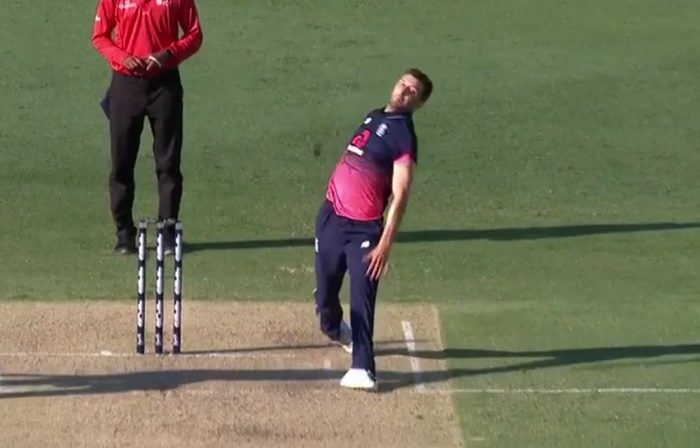
Speaking about England’s Test bowling attack this week, Steve Harmison managed the rare feat of deploying the word ‘unit’ in a halfway meaningful way.
He told Sky Sports that England have to, “make sure that at any one given time they’ve got skill factor with the new ball, an X-factor bowler that can get a wicket out of nothing and control. It’s not about names, it’s about components and it is something England need to identify.”
He’s right that it’s about identifying the components of a cohesive attack more than it’s about lining up the best bowlers. A Test day is long and you need different qualities at different times.
If you have four guys doing the same thing, it makes for a boom or bust situation. As Harmison himself says: “If you go to Australia with four right-arm seamers bowling 80mph then you are going to get beat every time.”
England’s one-day team has long taken a different tack. They have new ball swing bowlers, a quick full bowler, a quick short bowler, a leg-spinner and a couple of off-spinners.
Each has a different approach to taking wickets and Eoin Morgan tries to wheel them out at the best time to exploit that approach, whatever it happens to be. Crucially, these bowlers aren’t all competing for the ball at the exact same moment, the way England’s Test attack are.



Three spinners taking wickets, lovely stuff.
Joe Root taking 2-31, lovelier stuff.
Eoin Morgan is a better captain than Joe Root because he’s more willing to bowl Joe Root – discuss.
Actually, don’t.
Eoin Morgan for Test Captain.
Time for another petition.
I would have picked Morgan for the Magellan Ashes. Partly because all the other middle order options were a Vince-Westley so having someone who’s at least a potential match-winner wouldn’t be a bad punt – but also because he might have some advice for a young captain when the pitch is flat and the batsman are dominating. Somesuch advice might have been: “Why don’t you have a bowl Joe?”
And if one of those is out of form or they fancy a change up for conditions, they have a left armer as next cab off the rank and a Ben Stokes.
Mind you, they also get runs to play with which can’t be said of the Test bowlers very often to be fair. If England bat first, they usually get millions to bowl at (increasingly regularly) or not much at all (in which case the game is usually pretty much dead anyway). If England bowl first, it seems to me that team are starting to panic a bit because they have no idea what a good score against England is any more.
I guess proving your point even more, I don’t actually think the bowling line up for ODIs is any better skills-wise than the Test one or even that good individually. They just get runs to play with, and Morgan has the option of saying “RA swing and OB are going round the park, try some leg spin and pace for a bit, then see how you deal with the offies in 7 overs time just when you’ve got used to Mark Wood wanging it down”.
Yes, as well as having bowlers to suit different conditions, there’s also the simple fact that a noticeable change in angle and pace can disrupt rhythm.
Wholeheartedly agree KC, I’m positive that variety increases chances of success over pure one dimensional skill. The 2013 ashes were won convincingly by a good side but the captain rotated bowlers far more frequently than he needed creating panic and “never allowing the batsman to settle”. There’s definitely a stats project for anyone willing enough to prove the point with maths…
But the West Indies at their best just picked four same-paced, right-arm bowlers. Worked for them for a while.
Touché.
And Roger Harper.
I’d forgotten how many wickets Carl Hooper took, actually.
Carl Hooper: the hard answer to the quiz question… which two players have scored 6000 Test and ODI runs, taken 100 Test and ODI wickets and caught 100 Test and ODI catches?
Bet you’re delighted how quickly that came round to Carl Hooper.
Except that Hooper didn’t score 6000 runs in either Tests or ODIs, according to Cricinfo… though he came close in both.
Does the question need to say “5000 runs”? (And does anyone else qualify if the limit’s lowered?)
In terms of the “easy” answer, astonishing how you can raise the question to “scored 11,579 runs in both Tests and ODIs, taken 273 Test and ODI wickets, and taken 131 Test and ODI catches”… handy player, that one.
Apropos to none of this…
…apart from an incredibly tenuous link via Jason Roy…
…here is a little trip down memory lane from the summer of 2011, which is the focus of my Ogblogging this weekend:
http://ianlouisharris.com/2011/07/07/middlesex-v-surrey-at-lords-twenty20-match-king-cricket-report-7-july-2011/
A King Cricket report to savour, via Ogblog.
http://www.espncricinfo.com/series/8368/statistics/1116914/afghanistan-under-19s-vs-ireland-under-19s-21st-match–group-d-icc-under-19-world-cup-2017-18
Apologies to Ireland U19s, who – having been thrashed by Pakistan and Sri Lanka – I had suggested might be obliterated by Group D’s unbeaten leaders, Afghanistan.
In fact Ireland beat Afghanistan, and in the end Pakistan topped the group. Ireland still finished last though.
In group C, England U19s (383/7) beat Canada U19s (101) by 282 runs, to top the group. Canada didn’t actually finish bottom of the group, though, because they had beaten winless Namibia earlier in the tournament.
We have an excellent report on this tournament appearing on the site next week.
What a teaser!